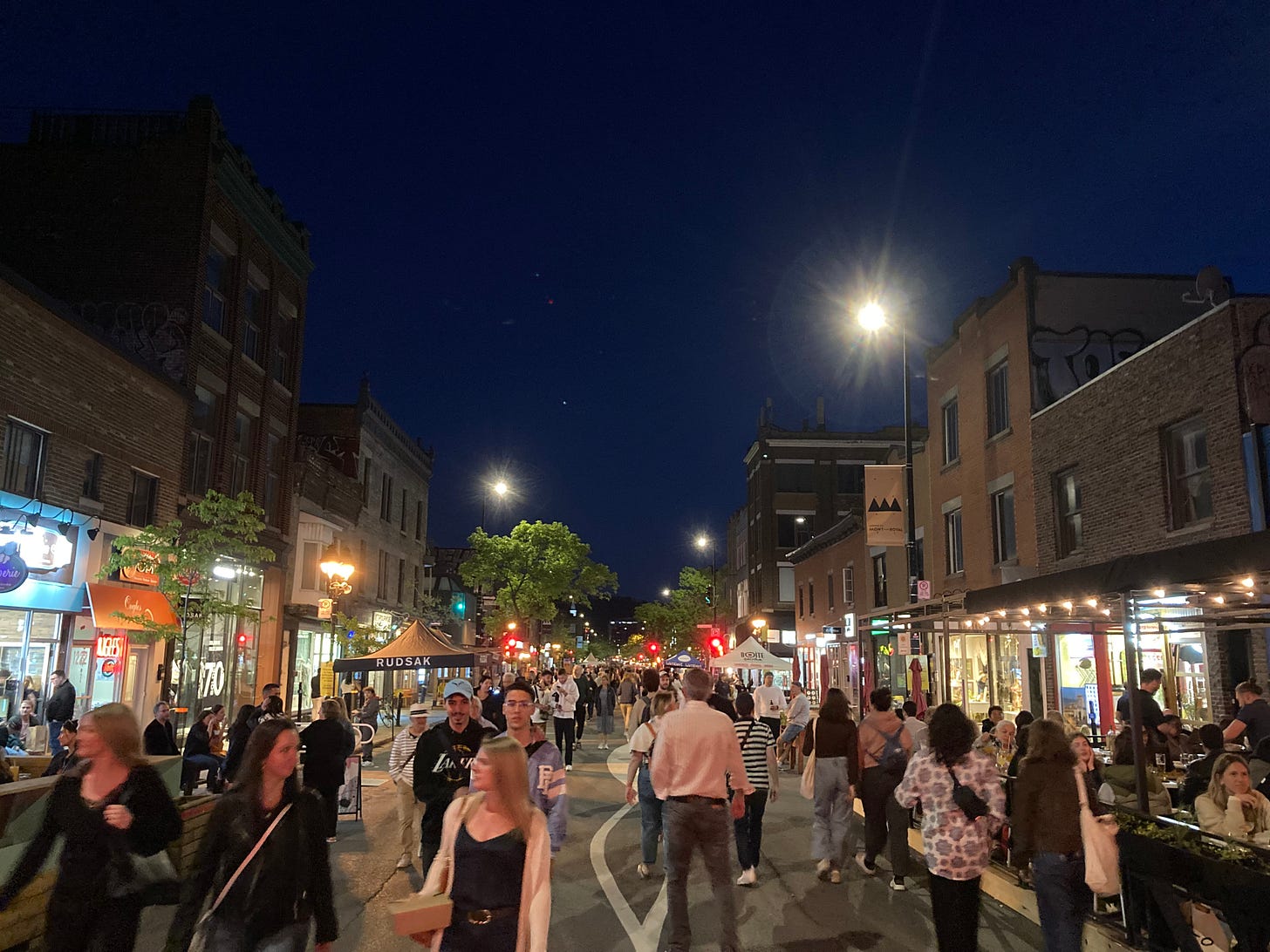In May, my wife and I visited Canada for a week, and we particularly loved Montreal. I wrote about it here, suggesting that it was a hint of what North American (i.e., not European) urbanism can be. Of course, it has French DNA in it, but then American cities have European DNA in them too. We’ve just really dropped the ball in a lot of ways. But lovely urbanism does not have to be an import.
I followed up on that piece here, with some photos and further thoughts.
But in this piece, I want to zero in on one particular evening we spent in the Montreal (with lots of photos, below). After dinner, we ended up on Mount Royal Avenue, which is closed to cars for an almost three-kilometer stretch in a central part of the city. Here’s the full pedestrianized stretch, of which we walked at least half:
From the sky, every block looks exactly the same. From the ground…they also kind of look the same! Honestly, that added to the effect. Just block after block after block of low-intensity, walkable, commercially vibrant urban fabric. It was really striking; something so familiar and natural, and yet so rare.
We walked from about 8:30pm to 9:30pm, during which we passed innumerable little attractions, with their own crowds around them: street stalls selling food, many belonging to restaurants which also had patio dining; dances or music performances; vendors selling books or clothing. On our way back, as night fell, many of the vendors were packing up, but there were still plenty of people out on the street.
At no point did I feel any sense of danger or caution. In my first Montreal piece, I wrote, “For me, cities were always places that took mental energy simply to be in.” That was completely absent here. As we finally headed down to a Metro station to get back to our hotel, we saw two couples relaxing in a park—now after 9:30pm—along with lots of other people. It takes a little time to realize, this is real. A city can be unbundled from American urban problems.
Each street scene looked the same, yet each was made of up of dozens or hundreds of different people, another batch of small businesses, and individual buildings. One corner has an A&W; another had a deli or diner; another has some other fast food shop. Here’s a ramen shop, here’s a pho shop. Here’s an Indian clothing boutique, here’s a consignment shop.
The pattern replicates over and over, but it’s so full of uniqueness and unselfconscious diversity. It’s a frame. A substrate. You can see busybody, radical government playing social engineer and closing streets to motorists. Or you can see people being freed to do what people have done for centuries or millennia in cities, after a very brief period of a few decades in which we forgot what cities were.
So here’s our night walk.
Pay real attention to the buildings. Most are only two or three windows wide. This scale is just perfect. And somebody built each one of those. So different, so alike.
The park at nightfall:
And a few more from different angles, and one of a performer at the subway station, around whom a small crowd was gathered.




I’ve walked in plenty of urban environments at night: often moving along briskly, often frankly bored.
But then there are these moments in life that feel like secular revelations; things that shape you, that you recount to people, that you use as reference points in your mind. This evening was one of those.
Related Reading:
Cities Aren’t Loud, Cars Are Loud
America’s Urban Heritage: Culpeper, Virginia Edition
Thank you for reading! Please consider upgrading to a paid subscription to help support this newsletter. You’ll get a weekly subscribers-only post, plus full access to the archive: over 700 posts and growing. And you’ll help ensure more material like this!













I don't understand. I cannot see a single car in any of these photos. How do people get around??
As much as people may complain I have never encountered anything other than people enjoying themselves when a street has been shut down to cars. Chicago, Denver, New Orleans, Memphis. I have been in all when they have closed all or part of a primary street downtown to traffic and just let people be free. And I have seen the same in smaller towns such as Idaho Springs, CO. Covid opened up alot of eyes to the possibility of reclaiming our public real estate for things other than cars and parking. I hope it continues.